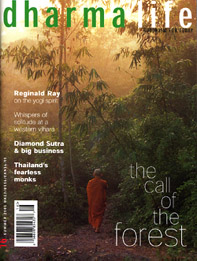Quietly Radical
Ordination for women has vexed many spiritual communities and traditions, particularly Christian and Buddhist, and in many faiths it is not even countenanced. The Western Buddhist Order is unique in the Buddhist world in that not only are men and women ordained on an equal footing but senior women Order members are responsible for performing ordinations. 'Buddhist Women Speak on Ordination' is a new video from Clear Vision, a Buddhist production company based in Manchester, that explores the WBO's ordinations from the perspective of those whom it has affected.
For Sangharakshita, the founder of the WBO, the equal ordination of men and women is one of the Order's central tenets. Although it is a new departure, in keeping with the Order's aim of bringing Buddhism to the modern world, he insists that there are precedents. 'This is not strictly a break with Buddhist tradition. Even in the Theravada [often viewed as the most conservative Buddhist school] women were first ordained by bhikkhunis [nuns], and then by monks.' But this practice died out and for centuries women practitioners were subordinate to men, and barred from full ordination. Yet Sangharakshita sees no necessity for this. 'If men were responsible for all ordinations, it would imply that women weren't quite capable of doing it.' Since serious female disciples are no less committed, he considers it appropriate for them to bear that authority.
The video shows the first ordinations of women by women, which took place in 1987 in India (where the Order is known as Trailokya Bauddha Mahasangha). For Padmasuri, one of those first preceptors, ordaining someone was 'a delightful experience'. The ordinations had considerable cultural significance in India - in that women were being ordained at all, let alone by other women. Women have tended to take second place in Indian society, and many believe that a woman's place is just to contribute money to support male practitioners. Ordination is a radical step for anyone to take, but especially so for an Indian woman.
The film includes interviews with women describing the mysterious process of ordination. Ordinands attend training retreats that explore the principles and practices of Buddhism. During these retreats friendship and understanding develop between preceptor and novice. On this basis, senior Order members assess when people are ready to make the commitment of ordination. Akasasuri was ordained by Ratnasuri, whom she knew well as a friend. However, during the private ordination ceremony Akasasuri experienced a new quality in her preceptor. 'I had a sense of a lineage behind her, going back to the Buddha. She seemed different, had more depth, and there was an ocean of loving-kindness in her eyes.'
The film also explores the effects on those conferring the ordination. The preceptor's role is to witness formally the ordinand's commitment to the ideals of Buddhism, referred to as, their 'going for Refuge to the Three Jewels'. For each woman it has meant taking her own Buddhist practice more seriously. Sanghadevi found that the weight of this responsibility was in no sense a bolstering of her ego. 'I've had to become more and more authentic. There's nothing to hold onto when ordaining someone. It's a very pure communication. All the dross has fallen away and you relate on the basis of what deeply matters in both of your lives.'
For Dhammadinna, witnessing this step in someone else fulfilled her own ordination with Sangharakshita some two decades earlier. 'It was like coming full circle.' To take on such a responsibility she 'had to close any mental "back doors" - of doubt or escape-fantasies. I was impelled forward.' Sanghadevi likened it to 'a one-way ticket to Enlightenment' - as to do justice to this responsibility one would need to be irreversibly on the path to the Transcendental.
This film is part of a larger project envisaged by Vidyamala of documenting Buddhist women: 'It is a way of reflecting ourselves back to ourselves. And it is a response to the lack of historical material on women practising down the ages for modern women to draw on. This is an exciting time in the history of Buddhism, with its arrival in the West, and its resurgence in India. It is historically unique for women to have so much freedom. And particularly in the WBO, as we have a teacher who encourages women to take so much responsibility.'
However, as Sanghadevi points out, 'In establishing a tradition of the Dharma in the West we need to have a long perspective. The fruits will be reaped in future generations.'
Vajrasara
Buddhist Women Speakon Ordination, Dir. Jo Hughes
Clear Vision 2001; £15 Available from 16-20 Turner Street, Manchester M4 1DZ, UK(+44 161 839 9579)



